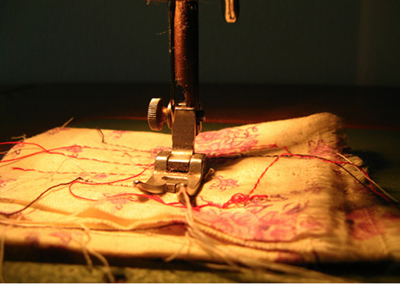Checklist of Common Sewing Machine Problems
Guide C-202
Wendy Hamilton
College of Agricultural, Consumer, and Environmental Sciences, New Mexico State University
Author: Professor and CES Grants and Contracts Development Specialist, Media Production Department, New Mexico State University. (Print friendly PDF)
Introduction
Little problems with your sewing machine can be very irritating and time consuming. They can happen to even the most experienced sewer. The next time you have machine troubles, look through your sewing machine manual for troubleshooting tips and check the lists below to see if you can determine the cause of the difficulty to correct it yourself. It may save you a service call and time. If you can’t correct the trouble, it is wise to seek professional help.

(FreeImage.com / Martin Boose)
To Avoid Breaking Needles
- Use the proper needle size for the weight of thread and fabric to be sewn.
- See that the presser foot or attachment is securely fastened to the bar and that the needle goes through the center of the hole.
- Avoid pulling fabric when sewing. The needle may become bent and strike the back of the needle hole.
- Use a needle that is the correct length. If it is too long, it will come in contact with the bobbin case and break. If it is too short, stitches cannot interlock.
- Be sure the needle is securely fastened in the needle bar.
- When sewing over pins, be sure they are perpendicular to the seam, keeping the heads of pins away from the stitching line.
Causes of Stitches Looping
- Looped stitches are usually caused by improper tension. If the loop is on the upper side, it may be corrected by loosening the top tension or by tightening the lower tension. If the loop is on the under side, it is usually best corrected by adjusting the upper tension. (Note: Some new model machines have factory set bobbins that should not be tampered with. Check your machine’s manual).
- Be sure that the upper and lower threading is correct and that the needle is of good quality and the correct size for the thread.
- Looping of stitches is sometimes caused by placing the bobbin in the bobbin case the wrong way. Check your machine’s manual for directions on inserting the bobbin.
- There may be lint, dirt, or thread between tension discs. Check your machine’s manual for ways to carefully remove it.
Causes of Upper Thread Breaking
- Needle is in backwards.
- Machine is improperly threaded.
- Tension is too tight.
- Needle is bent or has a blunt point.
- Thread is too coarse for the size needle.
- There is a burr on the needle hole of the presser foot (caused by breaking the needle when pulling fabric from the machine).
- Needle is too long for machine, or not inserted all the way into the needle bar.
- Take-up spring is bent or broken (have a professional replace the spring).
- Tension discs are worn so that thread works in a groove.
- Needle is too fine for size of thread and fabric to be sewn.
- Threads are not properly pulled back under presser foot when starting to sew.
- Lint or dirt has accumulated in or around bobbin case holder.
- Irregular sewing speed creates uneven thread tension.
Causes of Lower Thread Breaking
- The bobbin is improperly threaded in the bobbin case.
- Thread tension is too tight.
- Thread is wound unevenly on bobbin and/or the bobbin is wound too full.
- Spring on bobbin case is worn to a sharp groove.
- There is a burr on the underside of the throat plate (sometimes caused by sewing over pins or breaking needle).
- There is a knot in the bobbin thread.
- Lint, dirt, or thread has accumulated under the tension spring of the bobbin case.
Causes of Puckered Seams
- Tension is too tight.
- Stitches are too long for fabric being sewn, especially on fine fabric.
- Wrong presser foot is being used for the weight of the fabric.
- Puckered threads across seams are due to a blunt needle or too large a needle.
- Stitches are too short for synthetic and easy care fabrics.
- Using a plate with a wide needle hole may cause straight seams to pucker.
- Upper thread and bobbin threads are of a different size and/or type.
- Pressure foot is too heavy for the fabric being sewn.
- Fabric is pushed or pulled while stitching.
Causes of Machine Not Feeding Properly
- Pressure is incorrect for the fabric being sewn.
- The feed dogs are worn smooth. This can be determined by running your finger over the teeth. If they are not sharp, the feed dog should be replaced.
- The feed dogs are clogged with lint.
- The stitch regulator may have been turned back so far that the feed is entirely out of action.
- The needle may be bent.
- Spool of thread may jerk and catch if machine is operated too rapidly or at an uneven speed.
- Stitch regulator is incorrectly adjusted.
- The throat plate is incorrectly positioned.
Causes of Machine Working Heavily
- If the machine sounds or feels like it is working too hard after inactivity, it may be gummed up with oil and be in need of a general cleaning. For more information on cleaning your machine, see NMSU Extension Guide C-102, Sewing Machine Maintenance (https://pubs.nmsu.edu/_c/C102.pdf).
- The belt may be too tight and therefore puts excessive pressure on the bearings.
- If the belt is too loose, it slips on the balance wheel.
- Thread is jammed in the bobbin case.
Causes of Skipping Stitches
- Needle is not correctly inserted in the needle bar.
- Needle is too small for the thread being used.
- Needle is too short for the machine.
- Needle is blunt or bent.
- If a zipper foot is being used, the edge of the foot is too far away from the needle. Needle is threaded incorrectly.
- Needle hole in throat plate is too large.
- Pressure is too light.
- Upper tension is too tight.
- Upper thread and bobbin thread are of different sizes and/or types.
Causes of Stitch Length Variation
- Stitch regulator is incorrectly adjusted.
- Feed dogs are clogged with lint.
- Pressure is incorrect for fabric.
- Tension is incorrect for fabric.
- Throat plate is adjusted incorrectly.
- Presser foot is loose or not suited for fabric being sewn.
For further reading
C-203: Buying a Sewing Machine
https://pubs.nmsu.edu/_c/C203/
C-213: Free-motion Machine Embroidery
https://pubs.nmsu.edu/_c/C213/
C-218: Selecting an Overlock Sewing Machine
https://pubs.nmsu.edu/_c/C218/
C-102: Sewing Machine Maintenance
https://pubs.nmsu.edu/_c/C102/
Original author: Susan Wright, Extension Consumer Education and Health Specialist.

Wendy Hamilton is an Extension Evaluation and Accountability Specialist at New Mexico State University who provides expertise for program development and evaluation. She has worked at four land-grant universities, and has a diverse background in textiles and clothing, adult education, 4-H youth-at-risk, horticulture, evaluation, and grant writing.
To find more resources for your business, home, or family, visit the College of Agricultural, Consumer and Environmental Sciences on the World Wide Web at pubs.nmsu.edu
Contents of publications may be freely reproduced for educational purposes. All other rights reserved. For permission to use publications for other purposes, contact pubs@nmsu.edu or the authors listed on the publication.
New Mexico State University is an equal opportunity/affirmative action employer and educator. NMSU and the U.S. Department of Agriculture cooperating.
Reviewed December 2016


